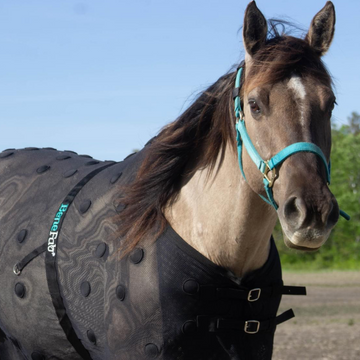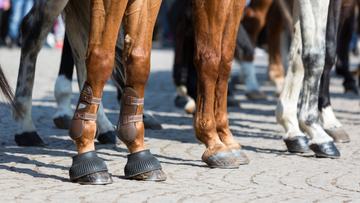Splint bones in horses are a common concern for horse owners, trainers, and veterinarians. These small bones are remnants of the horse's evolutionary development and can sometimes become a source of lameness or discomfort. Understanding the anatomy, function, and potential issues surrounding splint bones is essential for maintaining the health and well-being of horses.
Understanding Splint Bones in Horses
Horses have a unique anatomical feature known as splint bones, which are small vestigial bones on either side of the cannon bone in a horse's lower leg. There are two splint bones in each leg - the lateral splint bone and the medial splint bone.
The lateral splint bone is situated on the outer side of the leg, while the medial splint bone is found on the inner side. These bones are attachments for the interosseous ligament, which connects the splint bones to the cannon bone and helps stabilize the horse's leg during movement.
 Splint bones play a crucial role in a horse's flexibility and shock absorption while in motion. Although they are relatively small and slender, these bones are incredibly strong and have evolved to withstand the considerable forces that are exerted on a horse's legs during strenuous activities, such as galloping or jumping.
Splint bones play a crucial role in a horse's flexibility and shock absorption while in motion. Although they are relatively small and slender, these bones are incredibly strong and have evolved to withstand the considerable forces that are exerted on a horse's legs during strenuous activities, such as galloping or jumping.
Causes of Splint Bone Issues
Splint bone issues in horses can arise from several factors, primarily due to the horse's age, training, and exercise routines. These issues are more commonly found in young horses with immature bones. The young horse's training and exercise levels can contribute to splint bone problems if not carefully managed. Common causes include:
- Direct trauma to the splint bones.
- Poor conformation
- Concussion or repetitive impact.
Types of Splint Bone Conditions
Periostitis is the inflammation of the outer layer of the splint bone, commonly known as a "true splint." This condition usually results from trauma or excessive stress on the horse's leg.
Bucked shins are similar to periostitis but most commonly affect young racehorses in training. This condition is characterized by tiny stress fractures in the front of the cannon bones.
Desmitis refers to the inflammation of the ligaments surrounding the splint bone. This condition can be caused by excessive strain on the ligaments, trauma, or biomechanical imbalances in the horse's limbs.
Fractures of the splint bone can occur for various reasons, including direct trauma or as a secondary issue related to another condition.
Treatment of Splint Bone Conditions
Treatment for splint bone conditions in horses primarily focuses on reducing inflammation and pain, as well as promoting proper healing of soft tissue injuries. Developing a comprehensive treatment plan that addresses the specific condition is essential.
A combination of medical and physical treatments can effectively manage splint bone injuries.
Cryotherapy, or cold therapy, can be an effective method for managing the inflammation associated with splint bone injuries.
Rehabilitation programs are crucial to ensuring the horse's recovery and preventing further complications.
In some cases, surgery may be required to address splint bone conditions.
Managing with Medications and Therapies
In order to manage splint bone issues in horses, various medications and therapies can be employed. One of the primary goals in treating these conditions is reducing inflammation and pain, which can be achieved by using anti-inflammatory drugs.
Non-steroidal anti-inflammatory drugs (NSAIDs) are often prescribed to manage pain and inflammation. These medications include phenylbutazone (bute), flunixin meglumine (Banamine), and firocoxib (Equioxx). It is essential to follow the veterinarian's recommendations regarding dosage and duration, as excessive use of NSAIDs may lead to gastrointestinal issues or kidney damage.
Another option for reducing inflammation and promoting healing is cold therapy, which can be administered in various forms like ice packs or cold water hoses. Cold therapy is particularly useful in the initial stages after an injury, as it helps to alleviate swelling and numb discomfort.
Therapeutic ultrasound can be beneficial when dealing with chronic cases of splint bone injuries. This high-frequency sound wave therapy helps stimulate blood flow, which can expedite the healing process and reduce inflammation.
Supportive care is crucial in the management of splint bone issues. Proper bandaging techniques and the use of splint boots may provide additional support and protection for the affected limb. In some cases, corrective shoeing or special hoof pads can also aid in reducing stress on the splint bones and surrounding structures.
Role of Exercise and Diet
The role of exercise and diet is fundamental in maintaining the overall health of horses, including the well-being of their splint bones. Exercise plays a significant role in strengthening the horse's bones and joints. A well-planned exercise regimen can help reduce the risk of splint bone injuries. Regular workouts not only improve the horse's muscle tone, balance, and endurance but also increase bone density, making them more resilient against injury.
A properly balanced diet is equally important for horses. Providing the appropriate nutrients will significantly contribute to the health and function of the splint bones. The ideal diet for a horse includes a balance of forage, carbohydrates, proteins, fats, vitamins, and minerals. Some key elements in a horse's diet that directly impact the health of their bones include:
- Calcium and Phosphorus
- Vitamin D
- Protein
Prevention and Care Strategies
Proper care and management of horses can reduce the risk of splint bone injuries. Regular farrier work is crucial for maintaining healthy hooves and preventing undue stress on the splint bones. Farriers should perform routine shoeing and trimming to ensure the horse's hooves are well-balanced. This helps to distribute weight evenly and prevents unnecessary strain on the legs.
In addition to appropriate shoeing, bandages can provide support and protection for the horse's legs during exercise. Properly applied bandages decrease the chances of injury by offering stability to the lower limbs. It is essential to use appropriate bandaging techniques and materials, as improper application can cause more harm than good. Benefab Smart QuickWraps and VersiWraps are both great options for legwear that is supportive AND beneficial! Try them today, risk-free, with a 30-Day MONEY BACK GUARANTEE!
Regular exercise and training should not be overlooked, as this helps to maintain the horse's overall health and muscle strength. Gradual increases in work intensity can build fitness, while sudden jumps in workout intensity can lead to injuries. Be mindful of the training surface, as hard and uneven ground can increase the risk of splint bone issues.
Monitoring the horse for any signs of discomfort or swelling in the splint bone area is a critical component of prevention. Early detection can result in prompt intervention, which can prevent more severe problems down the line. If an injury is suspected, consult a veterinarian for further examination and treatment options.






















